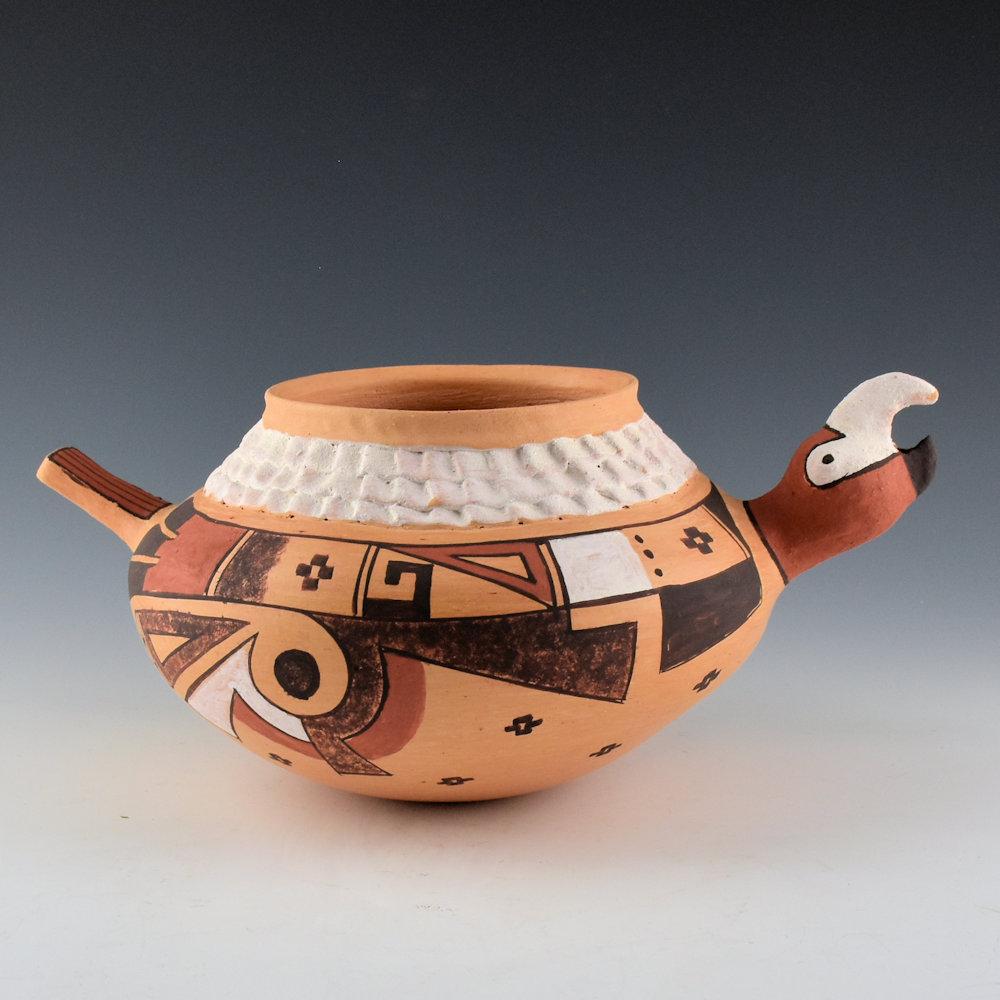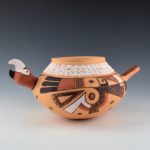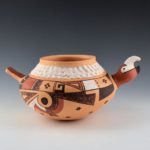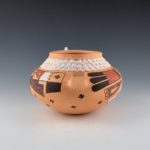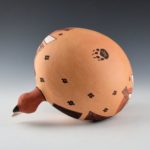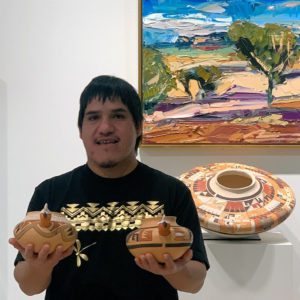- Photographs: King Galleries
This effigy of a Macaw parrot has historical roots that bridge two pueblos: Hopi and Zuni. On the one hand it was formed by a Hopi man and is closely modeled after examples from the ancient Hopi village of Sikyatki, like the one included in the Cooke Collection at the Museum of the West, Scottsdale:

Cooke bird effigy
The two other macaw effigy pots in this collection have this same basic form (2016-09 and 2019-06).
On the other hand, effigy 2020-08 carries a Matsaki (ancient Zuni) design, and is a product of Zuni pueblo: it is made of Zuni or commercial clay, was formed at Zuni where Bobby is living and fired there in a commercial kiln.
Form:
The walls of the pot are even and substantial, but not thick. Just below the lip are three bands of 37, 40 and 42 corrugations, reflecting the style of ancient Anasazi cookware (cf 2012-10). The tail and head appear to be solid and were added to the formed pot. Like pot 2020-07 (also by Bobby), the pot was made of clay that was either dug at Zuni or is commercial. Pots by Anderson Peynetsa of Zuni are said to be made of local clay and seem made of the same material as pot 2020-07 and this pot. A “thunk” with a finger on the lip of vase 2020-08 results in a high-pitched sound, strong evidence that the pot was kiln fired.
Design:
The design on pot 2020-08 is adapted directly from a ca 1550–1600 CE Matsaki bowl in the Cooke Collection at The Museum of the West, Scottsdale and is published in Cooke and Wade, 2012, 88-89.
The three bands of corrugation are painted white with kaolin clay. All other elements of the painted design are outlined with a thin black line. Much of the head is painted red with a white mask around the eyes that extends to the upper beak. The shorter lower beak is black. The flat, rectangular tail displays four red stripes.
The major design pattern is drawn on each side of the pot and appears twice. However the designs do not have the same orientation on each side but rather follow each other in order, like two birds flying in formation, the beak of one following the tail of the other. Between the two renditions are singular, small elements.
A linear band of elements lies at the top of the design. Each segment of design is separated from its neighbor by two vertical lines in an unpainted strip, a “one-lane highway.” One end of the design is an unpainted rectangle enclosing two elements. The first is a shape like four bricks forming a box with two additional brick “wings” off the long sides. A version of this form was first seen in this collection on a bowl by Nampeyo, 1996-05. Following is a vertical series of three black dots., then a white square, then a two-lane highway. The next segment is a rectangle diagonally divided in half. The top segment is filled with a red right-angle triangle with a smaller, unpainted triangle at its center. Below the diagonal a thick-based crook with three 90-degree turns intrudes into the unpainted surface. Following another two-lane highway, a version of the brick-box design is centered in an unpainted space, followed by a stippled element at the far end. Following a final highway border, is a large, solid red square and from its far edge emerge three solid black feathers with rounded tips.
Pendant to this linear section is a more energized design centered on a large red dot. Outlined with a particularly thick black circle, the red dot floats in a large unpainted circular space. attracting the viewer like a bullseye. Against the right boundary of this circle is affixed a large stippled form somewhat shaped like a plumber’s wrench with a large, slightly triangular, handle to the right parallel to the linear design above, its “jaws” conforming to the central circle and a wedge-shaped protrusion pointing downward. To its left is a smaller white element, also shaped a bit like a wrench, its jaws also conforming to the central circle and its handle also a bit wedge-shaped. Between the handles and exterior to the two jaws of the two wrenches, a red stripe runs along the exterior of the central circular motif, interrupted by a linear element of the larger wrench. Thus many of the elements that surround the central red dot have both circular portions that reinforce the bullseye pattern of design but also introduce linear forms that radiate from this central pattern.
The central circular pattern is not intact, however, but is open at about the 10 o’clock position so that the unpainted section of the center seems to pour through this gap to the left. As it exits, it is bounded above by the linear tails and below by the angled handle of the white wrench. Floating in this space is a large, stippled, isosceles triangle with a smaller unpainted isosceles triangular at its center.
Separating the two design patterns behind the head of the bird is a curved triangle based on the design to the left with its point just touching the tail of the design to its right, thus barely connecting the two major patterns of design. Similarly, above the tail is a free-floating “brick box” element is also positioned between the larger design patterns. Fifteen additional ” brick-box” elements float randomly on the otherwise unpainted belly of the bird.
The overall effect of this pattern of design is energized and pleasing. The stable linear band of design above contrasts with the circular energy below. This circular pattern is not balanced, but is contradicted by radiant wedges and the large triangular element entering the gap. The rightward motion of that triangle is contradicted by the leftward motion of the smaller red triangle in the linear design above. The bullseye centers a viewer’s eye and coalesces the design. Thus the design has both stability, contradiction, centrality and radiant motion. Here are some photographs of Bobbie with his finished bird effigies and a photograph of his workbench:
- Photographs; King Galleries
In the past Bobby worked with Tim Edaakie of Zuni to produce pottery, Bobby forming the pots and Tim doing the painting. Unfortunately Tim died in 2020, age 43. Bobby both formed and painted effigy 2020-08. As noted earlier, the design on this effigy is derived directly from a Matsaki bowl in the Cooke Collection (Wade and Cooke, 2012:88-89). Matsaki is an ancient (1475 to 1680 CE) Zuni pottery type that was derived from Sikyatki, an ancient Hopi pottery type. (See Matsaki bowl 2012-22.) Together Matsaki pot 2012-22 and effigy 2020-08 demonstrate the saying “What goes around comes around,” though the Matsaki bowl looks like Hopi but was made at Zuni and effigy 2020-08 combines ancient Hopi form with Zuni Matsaki design and was made at Zuni by a Hopi-Tewa. Beauty in diversity.

